 Image search results - "kaido" Image search results - "kaido" |

Ishibe-juku was the 51st stage/post or shukuba lodging town on the Tokaido Road where even Emperor Meiji once stayed (with an entourage of over 3,000). View from JR Ishibe Station. Ishibe in Konan city is rural, yet it has a few major industries operating.
|
|

Kusatsu-juku was the fifty-second station on the Tokaido Road (following Ishibe-juku) and the sixty-eighth station (following Moriyama-juku) on the Nakasendo Road. During the Edo Period, Kusatsu was an important post town at the crossroads of both roads.The roof is shaped like a Honjin lodge, with a gate. 草津駅
|
|

JR Ishibe Station platform.
|
|
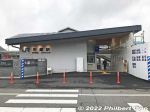
New JR Ishibe Station, Kusatsu Line. New station under construction in late 2022.
|
|

JR Ishibe Station before renovations.
|
|

JR Kusatsu Station
|
|

JR Ishibe Station
|
|

Kusatsu town map. Kusatsu basically developed along the old Nakasendo and Tokaido Roads as they intersected before going on to Kyoto, Shiga's neighboring prefecture.
|
|

In front of JR Ishibe Station. There are many bicycle garages for out-of-town students who commute from the station to their high school in Ishibe.
|
|

Kusatsu River
|
|

Gate in front of Ishibe Station
|
|

Oiwake Guidepost road marker at the intersection of the Tokaido and Nakasendo Roads. The left side says "Left for Nakasendo Road" and the right side says "Right for Tokaido Road."
|
|
|
|

Road marker at the intersection of the Tokaido and Nakasendo RoadsThis tunnel goes under the Kusatsu River.
|
|
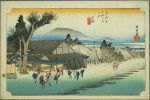
Hiroshige's woodblock print of Ishibe-juku (51st post town on the Tokaido) from his "Fifty-Three Stations of the Tokaido Road" series. A tea house is depicted.
|
|

Dengaku Chaya tea house reconstructed in 2003 based on Hiroshige's ukiyoe print of Ishibe. A rest place for tourists. Walkable from Ishibe Station. 田楽茶屋The original tea house as seen in Hiroshige's print was located some distance away (nearer to Ritto) from the location of this reconstructed tea house.
|
|

Road marker plaque
|
|

Inside reconstructed tea house
|
|

Kusatsu historyBeing a stage town along the Tokaido Road connecting Edo (Tokyo) and Kyoto, Kusatsu had over 70 inns for travelers. The best inn was the Honjin, reserved for daimyo warlords, Imperial family members, etc.
|
|

Site of Kojima Honjin and Emperor Meiji marker. The Kojima Honjin was Ishibe-juku's best accommodation suited for feudal lords and emperors.
|
|

Kusatsu-juku Honjin on the Tokaido Road. MAP
|
|

Ishibe was usually the first overnight stop for travelers going from Kyoto to Edo (Tokyo). The Honjin is no longer in existence, and only a normal house sits on the site.
|
|

Kusatsu-juku Honjin. the Honjin was the town's most luxurious accommodation catering to society's elite like daimyo warlords, Imperial family members including the emperor, and other dignitaries. National Historic SiteAt stage towns along the major roads like the Nakasendo and Tokaido, the Honjin was the town's most luxurious accommodation catering to society's elite like daimyo warlords, Imperial family members including the emperor, and other dignitaries. It operated during 1635 to 1870. The Honjin is now a museum.
This Honjin in Kusatsu is a very impressive example of traditional architecture. It is designated as a National Historical Place. It underwent a complete renovation and reconstruction during 1989 to 1995. (In case you wonder why such an old building looks so new.) Admission 200 yen. 10-min. walk from Kusatsu Station.
|
|

Woodblock print of Ishibe-juku
|
|

Kusatsu-juku Honjin entrance. This Honjin in Kusatsu is a very impressive example of traditional architecture. It is designated as a National Historical Place. It underwent a complete renovation and reconstruction during 1989 to 1995. Admission 200 yen.
|
|

Entrance to Ameyama Cultural Sports Park, a low hill with various sports and cultural facilities and hiking trails.
|
|

Genkan Hiroma entrance hall straight ahead. It was the entrance for daimyo feudal lords. 玄関広間
|
|
|

About the Kusatsu-juku Honjin
|
|

Entrance to Shukuba no Sato, outdoor museum of stage town buildings 宿場の里 MAP
|
|

Sekifuda name plates in Genkan Hiroma entrance hall. This is what you see when you enter the Honjin through the Genkan Hiroma entrance hall. The name plate for the warlord staying at the lodge was displayed. 玄関広間This is what you see when you enter the Honjin through the Genkan Hiroma entrance hall. The name plate for the warlord staying at the lodge was displayed here.
|
|

About Shukuba no Sato. Interesting outdoor museum of Edo-Period buildings accurately reconstructed as was found in Ishibe-juku. You can find a farmer's house, merchant's house, inn, tea house, and warehouse. The inside is also quite authentic.
|
|

Kusatsu-juku Honjin corridor. Pass by numerous Japanese-style rooms. 畳廊下畳廊下
|
|

Gate 関所
|
|

Kusatsu-juku Honjin guest book. See the names of Kira and Lord Asano both of whom once lodged at this Honjin (at different times). These two men later became adversaries which led to the legendary chushingura or vendetta of the 47 masterless samurai. 大�You can see the names of Kira and Lord Asano both of whom once lodged at this Honjin (at different times). These two men later became adversaries which led to the legendary chushingura or vendetta of the 47 masterless samurai.
大福帳
|
|

Traditional farmer's house 農家
|
|

Jodan no Ma: Kusatsu-juku Honjin's best room in the house. Reserved for daimyo warlords, emperors, etc. 上段の間
|
|

Traditional farmer's house
|
|

Jodan no Ma - Kusatsu-juku Honjin's best room in the house. Reserved for daimyo warlords, emperors, etc. 上段の間
|
|

Traditional farmer's house
|
|

Jodan no Ma - Kusatsu-juku Honjin. The Gyokuza raised tatami mats was where the lord or Emperor slept or sat. 上段の間Reserved for daimyo warlords, emperors, etc.
|
|

Traditional farmer's house
|
|

Jodan no Ma - Kusatsu-juku Honjin's best room in the houseReserved for daimyo warlords, emperors, etc. The room had an elevated tatami mat for the person to sit and sleep on.
上段の間
|
|

Old farming implements (for irrigation)
|
|

Mukae Jodan no Ma 向上段の間向上段の間
|
|
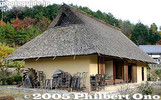
Farmer's house
|
|

Mukae Jodan no Ma. Painting on the fusuma sliding doors by Matsumura Keibun. 向上段の間
|
|

Merchant's house 商家
|
|

Urinal (made of lacquered wood) for warlords. The room has two tatami mats. Right below the urinal is a bamboo mat. Above is a small shoji paper window to provide light.
|
|

Merchant's house
|
|

Toilet (made of lacquered wood) for warlords. This is a separate room adjacent to the urinal. It also has two tatami mats. The walls are plain and not decorated. The toilet had a box which was likely replaced each time it was used. 上段雪隠This is a separate room adjacent to the urinal. It also has two tatami mats. The walls are plain and not decorated. The toilet had a box which was likely replaced each time it was used.
Jodan settin
上段雪隠
|
|

Inn (hatago) 旅籠
|
|

Marker for Emperor Meiji's visit and outdoor garden
|
|

Guest name plates in the inn
|
|

Outdoor garden
|
|

Ishiyama Station on the Keihan Line and JR Tokaido Line.
|
|

Inn
|
|
|

Inn kitchen
|
|

Yudono bath room for warlords. The hot water was heated nearby and carried to this room. 湯殿
|
|
|
|

Bath for feudal lordsLooks kind of small to me.
湯殿
|
|

Rice warehouse
|
|

Kitchen (Daidokoro doma). Dirt-floored room with wood-heated stoves. High ceiling with no chimney, but the ceiling has a covered opening. 台所土間
|
|

Rice warehouse
|
|

Honjin owner Tanaka's house
|
|

Tea house
|
|

Honjin owner Tanaka's house
|
|

Tea house
|
|

Honjin owner's house
|
|
|

Ceiling
|
|

Old fire truck
|
|

Kusatsu-juku Kaido Koryu-kan is a history museum with various exhibits showing Kusatsu's post town history. Admission 200 yen. You can buy a set ticket good for both the Honjin and this history museum. 草津街道交流館
|
|
|

Kusatsu-juku Kaido Koryu-kan. Terminals are provided to find information about Kusatsu. 草津街道交流館 MAP
|
|

Tokaido History Museum is adjacent to Shukuba no Sato. It explains the 53 stage towns of the Tokaido Road between Edo and Kyoto. 東海道歴史資料館
|
|

Kusatsu-juku Kaido Koryu-kan 草津街道交流館
|
|

Tokaido History Museum includes an accurate model of Ishibe-juku's palatial Kojima Honjin.
|
|

Kusatsu-juku Kaido Koryu-kan. Sample food from the old days, dinner on left and breakfast on right. 草津街道交流館
|
|

Ishibe Town logo
|
|

Photo op room at Kusatsu-juku Kaido Koryu-kan. You can dress up as a traveler on the Tokaido/Nakasendo Road and take a picture of yourself. You can even sit in the palanquin. A tripod is provided too. 草津街道交流館
|
|

Church house
|
|

Palanquin at Kusatsu-juku Kaido Koryu-kan 草津街道交流館For photos.
|
|

Church house
|
|

Ukiyoe prints of Kusatsu-juku at Kusatsu-juku Kaido Koryu-kan 草津街道交流館
|
|

Ishibe High School. Rare to see a Japanese high school whose name is shown in English.
|
|

Kusatsu-juku Kaido Koryu-kan草津街道交流館
|
|
|
|

Model of the town at the Kusatsu-juku Kaido Koryu-kan 草津街道交流館
|
|

Waki Honjin souvenir shop and restaurant脇本陣
|
|
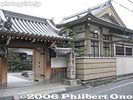
Temple with road marker
|
|

Closeup of road marker indicating the Tokaido Road to the right and Nakasendo to the left.
|
|

Mt. Akaiwa
|
|

View of Otaru as we head toward Akaiwa
|
|
|
|
|
|

View from Akaiwa of Cape Takashima. Todo Rock island on the left.
|
|

Climbing Mt. Akaiwa. Almost rock climbing with a ladder and rope.
|
|
|
|

View of the coast.
|
|
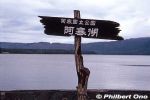
Part of Akan-Mashu National Park, Lake Akan (Akanko) is a serene crater lake in Hokkaido. In winter, the entire lake freezes over to enable ice skating and other winter sports. Winter festival is also held.
|
|
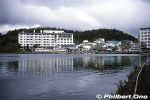
On the southern shore is Akanko Onsen hot spring with hotels and inns. Boat cruises also operate. These photos were taken years ago, so a few buildings might look different today. 阿寒湖温泉
|
|

Lake Akan's average air temperature is a low 3.7˚C. Winter temps can go as low as -17˚C. In summer, it can be as warm as 16˚C or 17˚C.
|
|

Lake Akan at sunset.
|
|

Lake Akan at sunset.
|
|

Akan-Kohan Youth Hostel was once here too. Not here anymore. 阿寒湖畔ユースホステル(既に閉館)
|
|

Bunk beds in Akan-Kohan Youth Hostel. 阿寒湖畔ユースホステル
|
|

Akanko Ainu Kotan is an Ainu village lined with gift shops and Ainu attractions. The path still had dirt when I visited, but it's now completely cobblestones. 阿寒湖アイヌコタン
|
|
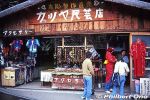
Akanko Ainu Kotan gift shop.
|
|

Akanko Ainu Kotan gifts.
|
|
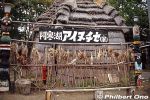
Ainu home (no longer here) was also in the Ainu village. 阿寒湖アイヌコタン
|
|

Akanko Ainu Kotan Ainu village. 阿寒湖アイヌコタン
|
|
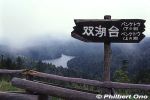
Near Lake Akan are two other small lakes, Lake Penketo (foreground) and Lake Panketo in the rear (not really visible due to fog). From Sokodai Scenic Point. 双湖台、ペンケトー
|
|
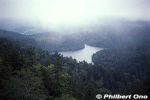
Only part of Lake Penketo can be seen from the road. Part of the Akan Volcanic Complex. ペンケトー
|
|

Lake Penketo's water flows to Panketo and ends up in Lake Akan. ペンケトー
|
|

The ocean seen from the JR Nemuro Line going to Kushiro.
|
|

Waste vegetable oil collection box sign.
|
|

One supermarket in Date, Hokkaido which has a waste vegetable oil collection box.
|
|

Near the entrance of the supermarket is the waste vegetable oil collection box.
|
|

Waste vegetable oil collection box with a few plastic bottles of waste oil left by customers.
|
|

A worker from Date Cosmos 21 comes to collect the waste oil.
|
|

Other waste oil containers.
|
|

This small building next to the Date Cosmos 21 Center is a waste oil conversion plant.
|
|

Waste oil tanks, each holding 1000 liters. The waste oil is first filtered.
|
|

The waste oil is fed to the conversion plant.
|
|

Through a chemical process, the waste oil is converted to biodiesel fuel.
|
|

Glycerine is removed from the waste oil.
|
|

The biodiesel fuel goes into this barrel.
|
|

The plant's control panel.
|
|

Bottles showing the waste oil conversion process from left to right.
|
|

Biodiesel fuel tank connected to a gas pump.
|
|

Filling up the gas tank with biodiesel fuel.
|
|

The non-toxic auto exhaust smells like tempura.
|
|

Bihoro Pass (Bihoro Toge) is on Route 243 going through the mountains on the border of Bihoro (north) and Teshikaga (south) Towns. Major tourist stop with great panoramic views of Lake Kussharo, Japan's largest caldera lake. The island in the lake is named Nakajima.
|
|

Bihoro Pass wooden marker at the scenic point. 美幌峠の標柱
|
|

Bihoro Pass is within Akan-Mashu National Park.
|
|

Lake Kussharo as seen from Bihoro Pass.
|
|
|

Bihoro Pass Scenic Point has two lookout points a short walk from each other. This is from the second lookout point. Both have similar views of Lake Kussharo. Bihoro Pass is within Akan-Mashu National Park in Hokkaido.
|
|
|
|

When I visited in autumn years ago, a few Ainu dressed in colorful costumes were at the Bihoro Pass scenic point posing for photos for paying tourists. アイヌ
|
|

Sapporo Station, morning train for Otaru.
|
|

Inside train to Otaru. It takes about 40 min. by regular train, and costs a mere 620 yen.
|
|

Milk shake with a Yubari melon flavor.
|
|

My favorite train station name: Zenibako Station. Zenibako means money box.
|
|
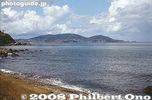
Otaru in sight from the train window.
|
|

Sign promoting the Hokkaido Shinkansen to be built.
|
|

Otaru Station
|
|

Otaru Station platform
|
|

Otaru Station
|
|

Inside Otaru Station
|
|

JR Otaru Station
|
|

Otaru Station
|
|

Otaru Station and bus terminal on the left.
|
|

Chuo bus terminal next to Otaru Station.
|
|

Billboard bus
|
|

Sign promoting the shinkansen to be built to Hokkaido.
|
|

View of Chuo-dori road from Otaru Station. Walk down this road to reach Otaru Canal.
|
|

Sign in English, Chinese, Korean, and Russian.
|
|

The former Temiya Line, Hokkaido's first rail line linking Otaru and Sapporo. It was discontinued in 1985.
|
|

Temiya Line
|
|
|
|

Karaoke place designed to blend in and conform to the area's building code.
|
|

Miyako shopping arcade
|
|

Miyako shopping arcade
|
|

Chuo-dori road looking toward Otaru Station
|
|

At the end of Chuo-dori is Unga Plaza which used to be Otaru Warehouse. Now find tourist info counter and gift shop.
|
|

Inside Unga Plaza
|
|

Unga Plaza inner courtyard.
|
|

Otaru Canal is a short walk from Otaru Station.
|
|

Otaru Canal has a large walkway alongside.
|
|
|

Some artists show their work here.
|
|

Otaru Canal
|
|

Otaru Unga. "Unga" means canal.
|
|
|

Murals showing some history of Otaru's marine transportation.
|
|
|
|

Otaru Canal
|
|

East end of Otaru Canal
|
|

East end of Otaru Canal
|
|

Warehouse along the Otaru Canal
|
|

Restaurant near Otaru Canal.
|
|

Rickshaw service available at the canal.
|
|

On approach to New Chitose Airport on an Air Do Boeing 767.
|
|

Landing on New Chitose Airport's runway 19L from a northerly approach.
|
|

Hello Hokkaido, it's been a long time since I've been here.
|
|

Arrival at the New Chitose Airport terminal.
|
|

The baggage crew worked very quickly. That's my bag rolling off the plane while I was still sitting in my seat waiting to get off.
|
|

New Chitose Airport, Hokkaido's main gateway, is the first place you see G8 Hokkaido Toyako Summit Welcome signs as we get off the plane.
|
|

Air Do Boeing 767 at New Chitose Airport.
|
|

New Chitose Airport, another Welcome sign as we head for the baggage claim area.
|
|

New Chitose Airport, another Welcome sign as we head for the baggage claim area.
|
|

Inside New Chitose Airport's Central Plaza, more G8 Hokkaido Toyako Summit Welcome signs.
|
|

Inside New Chitose Airport's Central Plaza, more G8 Hokkaido Toyako Summit Welcome signs.
|
|

New Chitose Airport's Central Plaza
|
|

New Chitose Airport's beautiful Central Plaza.
|
|

New Chitose Airport's Central Plaza
|
|

New Chitose Airport's Central Plaza
|
|

Inside New Chitose Airport's Central Plaza, G8 Hokkaido Toyako Summit countdown.
|
|

Inside New Chitose Airport at the check-in terminal, more G8 Hokkaido Toyako Summit Welcome signs.
|
|

The airport has a huge shopping area full of gift shops.
|
|

G8 Hokkaido Toyako Summit merchandise. They all seem to be unofficial goods. They don't bear the official logo.
|
|

Ramen shop sign.
|
|

Minami-Chitose Station
|
|

New Chitose Airport terminal
|
|

Going through the boarding gate at New Chitose Airport, Hokkaido.
|
|

Ze plane...
|
|

On the boarding bridge to the plane. Notice the G8 Hokkaido Toyako Summit Welcome signs.
|
|

In my seat. Calbee is a sponsor, selling potatoes and potato chips.
|
|

Rainy night for take-off.
|
|

Bye-bye Hokkaido...
|
|

The famous Clock Tower or Tokeidai is overshadowed by much bigger and modern buildings in central Sapporo. A short walk from Sapporo Station and Odori Park.
|
|

The Clock Tower was built in 1878 as part of the Sapporo Agricultural College established largely by three Americans from Massachusetts: Dr. Willian S. Clark, William Wheeler, and David P. Penhallow.
|
|

The Clock Tower was used as a drill hall and ceremony hall. After the college moved, the building was used by local citizens for cultural purposes such as a library and lecture hall.
|
|

The construction of the tower and installation of the clock was completed in 1881. The clock was made by Howard Clock Co. of Boston, MA. It is still in the Clock Tower, sounding its original chime.
|
|

Front entrance of the Clock Tower.
|
|

The Sapporo Clock Tower is an Important Cultural Property.
|
|

The clock inside the tower is Japan's oldest. The gears and other main parts are also still the original ones. Thanks to excellent care and maintenance, the clock has come this far.
|
|
|
|

Inside the Sapporo Clock Tower. The first floor has various display panels and exhibits.
|
|

The exhibits explain about the history of Hokkaido's early settlement and development.
|
|

Scale model of what the Sapporo Agricultural College looked like. Notice the Clock Tower. In those days, Sapporo's population was only 2,600.
|
|

Records of songs which mention the Clock Tower.
|
|
|
|

Panel showing foreign instructors who taught at Sapporo Agricultural College.
|
|

Second floor of the Clock Tower. Mostly pews for a lecture hall.
|
|

A working clock
|
|

On New Year's Eve, a crowd gathers to hear the Clock Tower ring in the New Year.
|
|

JR Date-Mombetsu Station on the Muroran Line. Date's main train station. 伊達紋別駅
|
|

Inside JR Date-Mombetsu Station
|
|

Date: Town of Bushido. Warrior's helmet on JR Date-Mombetsu Station train platform. The city has a samurai past.
|
|

JR Date-Mombetsu Station overpass
|
|

JR Date-Mombetsu Station stairs have wood.
|
|

JR Date-Mombetsu Station overpass. The station has a certain weathered, rustic charm.
|
|

JR Date-Mombetsu Station stairs to the train platform.
|
|

JR Date-Mombetsu Station train platform.
|
|

Train at JR Date-Mombetsu Station
|
|

Street corner sculpture of a couple in love. Perhaps in reference to a romantic "date."
|
|

Bus stop in central Date.
|
|

Bus for Toyako Onsen Spa. They don't run that often, but are more convenient than a train if you want to go to Lake Toya.
|
|

Donan Bus company provides bus service in this area. 道南バス
|
|

Date Onsen Spa and cherry blossoms. There is a hot spring lodge with 58 rooms and a sauna. Reasonable rates. Non-guests can bath in the hot spring for 390 yen. Phone: 0142-25-1919
|
|

The new JR Sapporo Station is definitely the city's most noticeable change in recent years. It is a huge complex, a far cry from the old train station.
|
|

This is Minami-guchi or the South Exit. On the far right is the JR Tower.
|
|

Sapporo Station is nicknamed "Satsu-eki."
|
|
|

Sapporo Station front and center on the south side.
|
|
| 2657 files on 11 page(s) |
1 |
 |
 |
 |
 |
|